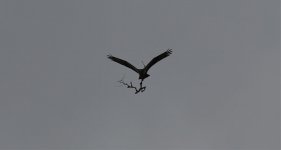Hello all, I'm living and Birding in India, and an avid eBirder. I often look at the handy target lists they can generate, and it's made me really curious how eBird, local reviewers, and rarity committees make the cutoff on the arbitrary distinction of a a bird is considered "rare."
In places like India where distribution is not as well known, I find this to be a particularly interesting question, but also in places where now is known. For instance, does a know how ABA codes are determined?
Any input or discussion is welcome!
The eBird software shows RARE in red letters whenever a species is triggering the filter set by the reviewer. You can see a flock of 13 Bar-headed Geese, but if the filter is set to 12, the software sees it the same way as if you saw 13 Californian Condors or 1 Californian Condor (in India).
Now there are all kinds of reasons why the filter is set lower for a particular species:
-a species may be out of its range (wind-blown migrant) so you are not expected to see any; if you have seen it, great, it is a rarity; but you have to provide evidence such as clear photos in order for it to be validated by the committee;
-a species was split into two, and you are trying to enter the other new species that now lives only in Indonesia, not the one which lives in India; this problem appears when someone is using an old field guide book, made before the taxonomic changes.
-two species are very difficult to tell apart, and while experienced birders make great effort to carefully scrutinize each photo pixel by pixel, and discuss it in committees and forums, some new birders may just assume it is the more common species and enter it in eBird as such. Setting the filter values low causes all records of this species to be caught by filter and the reviewer will see them.
-as already said, if there are separate filters for a mountain area and a nearby lowland, the montane species recorded in the lowland marsh will be flagged and a coastal species on mountain top will be flagged as well. If there are no separate filters, the value for a marginal species may be set lower so inexperienced eBirders will not report it unnoticed by the reviewer. I have set the filter low for several mountain-peak species. By now I have already discussed the situation with the few eBirders who live in mountains and they know that they can report their neighborhood bird every day and I will validate it under "Known to be at location", while birders from the lowlands will have to provide some evidence if they claim they saw it.
-you just saw a larger flock than expected. This is also OK, but the filter will stay low and your record will be accepted if you have evidence (or if it is just 22 birds instead of 20 etc.; if you saw 450 birds instead of 30 you need much more evidence).
etc.
. . .
Outside of eBird, birds are rated according to IUCN criteria on level of threat. The handbook for these criteria is several pages long (and complicated and tedious for the general birder; you would need results from various studies in order to assess a species according to each criterion) and special committees on national level meet periodically to review each species. They also send their results to international committees so we get a joined list such as the Red List of Birds of Europe.
It is quite possible to see a large flock of a species high on the threat list. Maybe it just happens to be a flocking species, but the number of such flocks is now much smaller than before as wintering or breeding grounds are destroyed in part of its range. One such species is Common Pochard. We all see the large flock of pochards every time we get to the bank of Danube in December but that is not indicative of its global rarity status.








